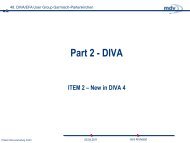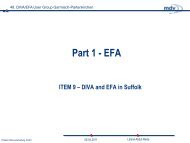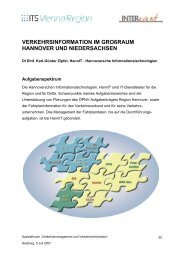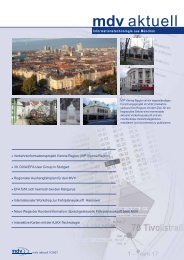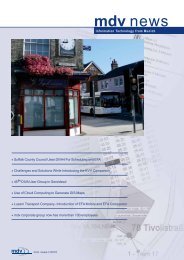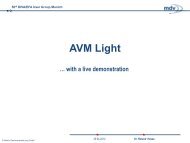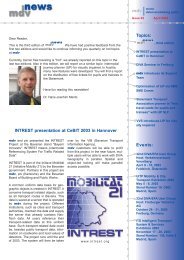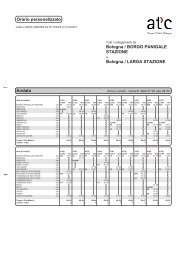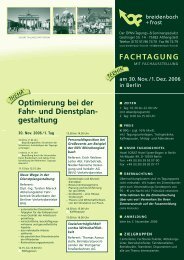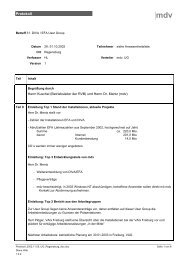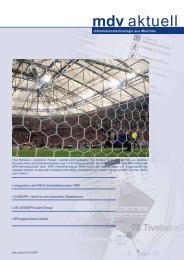II/2004 - Mentz Datenverarbeitung GmbH
II/2004 - Mentz Datenverarbeitung GmbH
II/2004 - Mentz Datenverarbeitung GmbH
Create successful ePaper yourself
Turn your PDF publications into a flip-book with our unique Google optimized e-Paper software.
Transfer Optimization with<br />
DIVA-Interval Timetable<br />
Every operator is interested in optimizing<br />
its processes. Generally, operators<br />
want to optimize those internal processes<br />
which decrease costs. However, it<br />
is very difficult to balance these optimizations<br />
with optimizations on the customer's<br />
side. But what would you say if<br />
you were handed a tool that makes your<br />
offered public transport services more<br />
attractive to your customers, increases<br />
your operator income, and at the same<br />
time decreases your operator cost? In<br />
case you are interested in this, DIVA-<br />
Interval Timetable could be the right tool<br />
for you...<br />
Transfer Optimization - what is it?<br />
All transport planners are familiar with<br />
the following problem: the passenger<br />
wants the public transport to have short<br />
time intervals, routes which follow the<br />
same path to be time-wise evenly distributed,<br />
and interchange transfers with<br />
minimal waiting times. In particular, the<br />
realisation of minimal waiting times for<br />
as many transfers as possible is a typical<br />
optimization problem. On the other<br />
hand, in order to reduce costs, the transport<br />
operator wants to manage blocks<br />
with the least amount of vehicles possible,<br />
while keeping with the operator's<br />
legal and technical requirements. This<br />
also influences the transfer situation<br />
along the route. It is not possible to<br />
satisfy both sides, passenger and operator,<br />
completely. So, at what point are<br />
the requirements of both sides optimally<br />
met?<br />
The experienced transport planner<br />
resolves this problem intuitively and<br />
realizes practical results. Because<br />
small changes in the interval-based<br />
timetable can often have a large impact,<br />
the transport planner bases the new<br />
timetable closely on the previous year's<br />
timetable. Thus, new approaches to<br />
solve the above mentioned problems<br />
are not to be expected, and as a result<br />
no clear improvement of the timetable is<br />
achieved. However, previously untapped<br />
economic potential can be gained<br />
with DIVA-Interval Timetable.<br />
Requirements for a transfer<br />
optimization<br />
It is expected that a tool for transfer optimization<br />
support the transport planner in<br />
each planning phase and give the transport<br />
planner information about all relevant<br />
planning data. It should be possible<br />
to: 1) easily define important transfer<br />
relations in the network, 2) have an<br />
overview as to whether or not the requirements<br />
at separate transfers are met<br />
mdv news <strong>II</strong>/<strong>2004</strong> - 6 -<br />
(transfer quality), 3) change departure<br />
time blocks easily via drag and drop and<br />
see the resulting impact on the network<br />
plan, 4) build and control blocks in consideration<br />
of waiting times, and 5) perform<br />
a fully automatic optimization of the<br />
timetable and place this proposed timetable<br />
to the disposal of the transport<br />
planner for further handling.<br />
Implementation in DIVA-Interval<br />
Timetable<br />
A consequent orientation towards the<br />
needs and conditions of transport operators<br />
was very important in the development<br />
of DIVA-Interval Timetable. This<br />
could only be realized through a close<br />
cooperation with larger transport authorities.<br />
During the development phase,<br />
the Transport Operator of Zurich (VBZ)<br />
and especially Mr. Andreas Weisskopf<br />
(Weisskopf Engineering AG), with his<br />
experience in the field of transfer optimization,<br />
assisted mdv. We would like to<br />
thank them for their assistance.<br />
The prototype for DIVA-Interval Timetable<br />
was implemented in the course of<br />
a project with the Transport Operator of<br />
Basel (BVB). Moreover, scientific<br />
research about the practicability of the<br />
program was done within the framework<br />
of a diploma thesis that was supervised<br />
by BVB and mdv. Another objective of<br />
the diploma thesis was to refine the<br />
parameterisation of the system, adjusting<br />
the parameters perfectly to the<br />
actual needs. These efforts were made<br />
to guarantee a high practicability of<br />
DIVA-Interval Timetable.<br />
We are convinced that the new product,<br />
DIVA-Interval Timetable, meets your<br />
requirements for an optimal transport<br />
planning tool. With DIVA-Interval<br />
Timetable it is sufficient to select route<br />
options that are available in the system<br />
and to define the transfer relations. Preset<br />
parameters help to work with as little<br />
input as possible. Afterwards, any timetable<br />
scenario can be run through and<br />
can be compared and optimized with<br />
respect to transfer and block quality.<br />
This is done easily by drag and drop of<br />
routes, with an immediate control of the<br />
result, or fully automatic via the DIVA-<br />
Interval Timetable Optimizer. Footpath<br />
times that are needed by the passenger<br />
to interchange are taken into account as<br />
well as eventual waiting times of the<br />
vehicles at the last stop of a block, automatically<br />
of course.<br />
DIVA-Interval Timetable offers even<br />
more<br />
With DIVA-Interval Timetable it is even<br />
possible to synchronize an interval timetable<br />
with (external) individual events.<br />
This includes, for example, important<br />
transfers with the national or international<br />
long-distance transport with which<br />
the timetables must be aligned.<br />
Moreover, it is possible to refine the<br />
input about routes and transfers. For<br />
example, DIVA-Interval Timetable enables<br />
the restriction of the validity time<br />
interval. Thus, the weekday and day<br />
time dependent requirements can be<br />
elegantly taken into account. Also, vehicle<br />
sequences (e.g. on trunk routes, tunnel<br />
routes, etc) can be defined, or DIVA-<br />
Interval Timetable can define the best<br />
sequence itself, etc.<br />
Conclusion<br />
The large positive feedback from the<br />
transport operators has shown us that<br />
we have hit the bull's eye with DIVA-<br />
Interval Timetable. We have developed<br />
a product that is apparently highly<br />
demanded. Other transport operators<br />
and authorities have already raised interest<br />
in DIVA-Interval Timetable.<br />
Mr. Iffländer, operating manager of BVB<br />
Basel: "With DIVA-Interval Timetable, finally<br />
a tool is available on the market that understands<br />
the important issue of transfer optimization.<br />
The implementation by mdv can be<br />
seen as elaborate and highly successful. We<br />
are very enthusiastic about the possibility to<br />
run through different scenarios with respect<br />
to quality for a complicated network time<br />
schedule within a short amount of time.<br />
DIVA-Interval Timetable will be an important<br />
part of our transport planning in the future.<br />
With this tool we can considerably increase<br />
our passenger satisfaction and thereby the<br />
acceptance of public transport."



